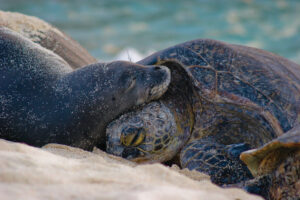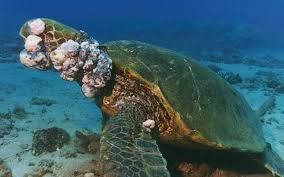
Unseen Impacts: Toxoplasmosis and Fibropapillomatosis
By Kathleen Barkats
In addition to its beautiful beaches, Hawaii is home to many marine animals. As a visitor or resident, it is common to experience Hawaii’s wildlife, such as sea turtles popping their heads up from the water and Hawaiian monk seals resting on the beach. Unfortunately, marine species like these face many environmental threats including debris entanglement, physical trauma, habitat loss, and many more. These important issues come to the forefront of environmental discussion because of how broadly they impact the oceans. However, there exist lesser-known issues that pose particular threats to specific species. For the Hawaiian monk seal, Neomonachus schauinslandi, toxoplasmosis is a life-threatening disease. Fibropapillomatosis is the similar disease for green sea turtles, Chelonia mydas. Human activity is likely perpetuating these diseases, which pose serious threats to both species.
Toxoplasmosis is a parasite spread by cats, the only definitive hosts (Dubey 2016). This disease can be transmitted to humans also, and is a primary concern for pregnant women where the disease can cause birth defects. In the marine environment, toxoplasmosis can impact marine mammals such as the endangered Hawaiian monk seal and dolphins.
Toxoplasmosis spreads through a specific sequence of events. The parasite is present in intermediate hosts like mice and birds and it is passed on to animals that consume these hosts. When cats predate these intermediate hosts, they consume parasitic cysts and become infected. Toxoplasmosis reproduces exclusively within cats, who shed the oocysts (the egg form of a parasite) through their feces and spread the parasite throughout the environment. Toxoplasmosis oocysts work their way into waterways that feed into the ocean. As a result, Hawaiian monk seals and dolphins can ingest the parasite through consumption of prey in the marine ecosystem.
 Toxoplasmosis is a major cause of death in Hawaiian monk seals in the main Hawaiian Islands. It has killed at least eight animals since 2001 (NOAA 2018) and this is very significant given the small remaining population of these endangered animals. According to the Center for Disease Control, symptoms in humans generally present as flu-like, although some infections remain asymptomatic. As such, the disease is difficult to detect and treat in any species. Seals with toxoplasmosis can face impaired reproductive, brain, and immune system functions (NOAA 2019). Animals that do not die from the disease become much more vulnerable to natural environmental stressors.
Toxoplasmosis is a major cause of death in Hawaiian monk seals in the main Hawaiian Islands. It has killed at least eight animals since 2001 (NOAA 2018) and this is very significant given the small remaining population of these endangered animals. According to the Center for Disease Control, symptoms in humans generally present as flu-like, although some infections remain asymptomatic. As such, the disease is difficult to detect and treat in any species. Seals with toxoplasmosis can face impaired reproductive, brain, and immune system functions (NOAA 2019). Animals that do not die from the disease become much more vulnerable to natural environmental stressors.
There is an incredibly large population of feral cats in Hawaii and these animals rapidly spread toxoplasmosis oocytes throughout the environment. To reduce this impact, humans should avoid feeding and interacting with feral cats as it supports the population. Instead, opt for environmentally safer alternatives like catch and release sterilization, adoption and broader feral cat management strategies. In the same vein, domesticated cats must stay indoors unless supervised. Outdoor cats can unfortunately put the lives of native fauna, like seabirds, at stake. Some countries with problematic feral cat populations, such as Australia and New Zealand, have introduced eradication operations to minimize damage to native ecosystems.
While monk seals struggle with toxoplasmosis, sea turtles face Fibropapillomatosis (FP), which is a viral infection. Both green sea turtles (honu) and hawksbill sea turtles (‘ea) live in Hawaii, with hawksbill turtles being very endangered. While HMAR responds more often to green sea turtles affected by FP, all turtle species are vulnerable to its impacts. FP is presumed to be a strain of herpes; however, there is no substantial evidence to support this theory other than the quick spreading of the virus and the fact that there is no known cure (Whitehouse 2015).
 Fibropapillomatosis presents as tumors that appear on the faces, bodies, and vital organs of sea turtles. Because not all tumors are visible to the naked eye, it can be impossible to tell if green sea turtles are infected. Those with external tumors can have impaired vision or mobility, putting them in danger in the surrounding environment, while internal tumors can impair the function of vital organs. Individuals can die from these tumors whether they are internal or external, and attempts to remove tumors often become thwarted by recurrence. Humans do not yet have a clear understanding of how this disease spreads. Research from the University of Hawaii at Manoa indicates that nitrogen runoff in the nearshore ecosystem could be linked to tumor growth. Nitrogen increases the amount of the amino acid arginine in invasive algae and seaweed, which are staples in the sea turtle diet. Studies show that arginine actually promotes the FP virus (Smith and Zimmerman 2014). Chris Whitehouse proposes another theory in his 2015 overview of FP. He suggests that FP could be transmitted between honu through direct contact of uninfected turtles with infected turtles, although there is no certain conclusion.
Fibropapillomatosis presents as tumors that appear on the faces, bodies, and vital organs of sea turtles. Because not all tumors are visible to the naked eye, it can be impossible to tell if green sea turtles are infected. Those with external tumors can have impaired vision or mobility, putting them in danger in the surrounding environment, while internal tumors can impair the function of vital organs. Individuals can die from these tumors whether they are internal or external, and attempts to remove tumors often become thwarted by recurrence. Humans do not yet have a clear understanding of how this disease spreads. Research from the University of Hawaii at Manoa indicates that nitrogen runoff in the nearshore ecosystem could be linked to tumor growth. Nitrogen increases the amount of the amino acid arginine in invasive algae and seaweed, which are staples in the sea turtle diet. Studies show that arginine actually promotes the FP virus (Smith and Zimmerman 2014). Chris Whitehouse proposes another theory in his 2015 overview of FP. He suggests that FP could be transmitted between honu through direct contact of uninfected turtles with infected turtles, although there is no certain conclusion.
Unlike toxo, FP proves more challenging to prevent. According to the US Army Medical Research Institute of Infectious Disease, FP prevalence was diminished by the removal of infected animals in some areas of Hawaii. Sea turtles usually inhabit near-shore environments where pollution and runoff are often greatest. By cleaning coastal waterways and shorelines, or supporting regulation of permitted runoff, we might reduce pathogens that can cause FP to develop in the first place. In addition, reporting sightings of injured or infected sea turtles help HMAR and NOAA keep track of the prevalence and spread of this disease.
Sea turtles and Hawaiian monk seals are keystone species, so toxoplasmosis and FP impact the function of the wider Hawaiian marine ecosystem. Both are particularly susceptible to pathogens in the oceans and help indicate the health of ocean environments. Thus far, these diseases have been nearly impossible to eliminate, so humans must take preventative action to minimize the contribution to these deadly diseases. Becoming informed of the issues facing monk seals and sea turtles helps us understand the impacts of our daily choices. Supervising pets, minimizing pollution, and reporting distressed marine animal sightings are significant forms of assistance. These small adjustments bring us closer to allowing monk seals and sea turtles to thrive in the generations to come.
